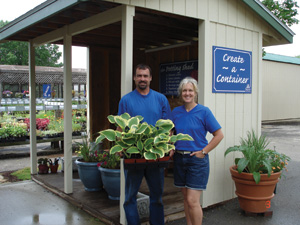8/15/2008
Creative Planning
Barbara Mulhern
 Jim and Shelly Garbe don’t like to think about a soft economy any more than anyone else. But they believe in planning ahead—whether it involves downsizing or finding a new way to market while achieving greater efficiencies.
Jim and Shelly Garbe don’t like to think about a soft economy any more than anyone else. But they believe in planning ahead—whether it involves downsizing or finding a new way to market while achieving greater efficiencies.
“The wholesale side of our business has slowed down, but we planned for this,” says Jim, co-owner with his wife, Shelly, of Shady Acres Perennial Nursery in New Berlin, Wisconsin. “We have been downsizing the last couple of years on our own. We reduced our staff down to five full-time, and took down some greenhouses to put in a storm-water pond. We’re trying to become more efficient.”
Jim was working as an electrical engineer and Shelly as a bookkeeper when they decided in 1995 to buy both the nursery and the house that had belonged to Jim’s parents. “I grew up in the business,” Jim says. “I was helping haul flats when I was eight years old. My parents started the business in 1958 with trees and shrubs but switched to perennials in the ’70s. The trees and shrubs were getting too physical for my dad. He also saw an opportunity for an emerging market.”
Today, Shady Acres grows predominantly perennials, along with a few annuals and herbs. Ninety-eight percent of the product they sell is grown on site. Propagation is done inside the greenhouses, and they use outdoor hoop houses for overwintering perennials.
About two-thirds of Jim and Shelly’s market is wholesale. The rest is retail. “Our wholesale business is split between landscape contractors, mostly in our area, and other independent garden centers around the state,” Jim says. “We have about 2,000 retail customers on our mailing list from all over the United States and Wisconsin. They are across the board in terms of income level.”
Finding a niche
The market that’s weakening the most out of all of Shady Acres’ markets is independent garden centers, Jim says. “I think they’re being pushed out by the big box stores,” he believes. Despite that, Shady Acres has found a niche. “We’re out in the country and we have a lot of different varieties,” he says. In fact, Shady Acres offers customers more than 1,100 varieties of perennials. “The tried and true—hostas, daylilies, the grasses—are very popular. People are looking for new things, but the tried and true always sell the best,” Jim notes.
Finding a niche also includes paying close attention to growing trends among customers, including the increasing interest in sustainability. “We’ve started a plastic pot recycling program for our customers,” Jim says. “We have a bin in our parking lot. Customers can bring in their pots they got from us or from others. We also use it for our own plastic.” Jim and Shelly also save and return pallets they’ve used, utilize slow-release fertilizer and reuse their plastic coverings.
Last year, Shady Acres installed a storm-water pond to handle rain water and irrigation runoff. But the pond does much more. “We showcase the use of plants around the pond so people with larger homes can see the use of plants around ponds in subdivisions,” Jim says.
Shady Acres also has other display gardens around its garden center and around Jim and Shelly’s home, which is adjacent to the garden center. The display gardens change from season to season and from year to year.
“The idea is to show plants in their mature stages at three, five, seven years,” Shelly says. “This is so the customer can tell how the plants will look when they’re older and what they will look like with other plants.”
The display gardens are also used for trials of new varieties. The Garbes are careful, though, not to try to sell a new plant that doesn’t meet their quality, hardiness and color standards. “Right now, a lot of our red and other color coneflowers are becoming very popular,” Shelly says. “But we’re still evaluating their hardiness.”
Helpful tips
The Garbes have these tips for other growers:
Constantly think of ways to make things easier for your customers. Three years ago, Jim and Shelly built a container potting shed off of Shady Acres’ parking lot. Customers bring in their own pots and can have them potted or re-potted there. “We provide the mess; the soil stays here,” Shelly says. This is, of course, also a good marketing tool. In addition, Shady Acres offers various workshops to its customers to help them with their gardens at home.
Don’t get too big too fast. “Sometimes it seems exciting but bigger doesn’t always mean better,” Jim says. “You may need to hire more employees or put in more equipment. And now your business will be so big that you have to deal with a lot of employees and personnel issues instead of talking to customers. If you enjoy talking to your customers, make sure you’re the one who can continue doing that.”
Give back to the industry. Jim is the current president of the Wisconsin Green Industry Federation and a past president of the Wisconsin Nursery Association. He thinks this is important because if you’re willing to give back to the industry, others will share their good ideas with you. “If you have an issue, you know you can talk to other people to find out how they fixed it,” he says. “I get good ideas from sod growers, nurseries, industry trade shows and others.”
Barbara Mulhern is a freelance writer from Verona, Wisconsin.